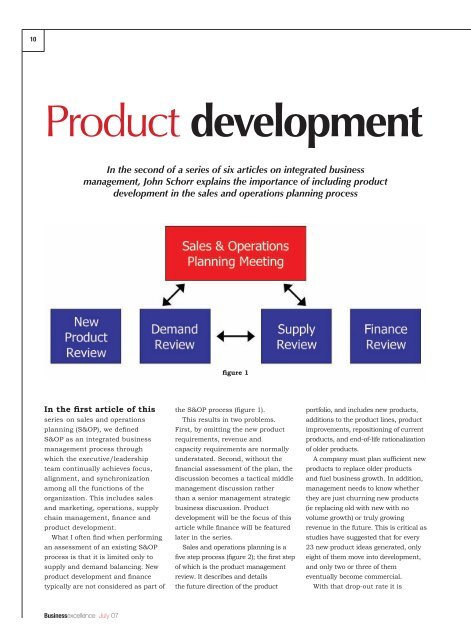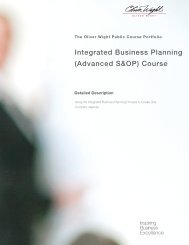Product development - Oliver Wight Americas
Product development - Oliver Wight Americas
Product development - Oliver Wight Americas
Create successful ePaper yourself
Turn your PDF publications into a flip-book with our unique Google optimized e-Paper software.
10<br />
<strong>Product</strong> <strong>development</strong><br />
In the second of a series of six articles on integrated business<br />
management, John Schorr explains the importance of including product<br />
<strong>development</strong> in the sales and operations planning process<br />
figure 1<br />
In the first article of this<br />
series on sales and operations<br />
planning (S&OP), we defined<br />
S&OP as an integrated business<br />
management process through<br />
which the executive/leadership<br />
team continually achieves focus,<br />
alignment, and synchronization<br />
among all the functions of the<br />
organization. This includes sales<br />
and marketing, operations, supply<br />
chain management, finance and<br />
product <strong>development</strong>.<br />
What I often find when performing<br />
an assessment of an existing S&OP<br />
process is that it is limited only to<br />
supply and demand balancing. New<br />
product <strong>development</strong> and finance<br />
typically are not considered as part of<br />
the S&OP process (figure 1).<br />
This results in two problems.<br />
First, by omitting the new product<br />
requirements, revenue and<br />
capacity requirements are normally<br />
understated. Second, without the<br />
financial assessment of the plan, the<br />
discussion becomes a tactical middle<br />
management discussion rather<br />
than a senior management strategic<br />
business discussion. <strong>Product</strong><br />
<strong>development</strong> will be the focus of this<br />
article while finance will be featured<br />
later in the series.<br />
Sales and operations planning is a<br />
five step process (figure 2); the first step<br />
of which is the product management<br />
review. It describes and details<br />
the future direction of the product<br />
portfolio, and includes new products,<br />
additions to the product lines, product<br />
improvements, repositioning of current<br />
products, and end-of-life rationalization<br />
of older products.<br />
A company must plan sufficient new<br />
products to replace older products<br />
and fuel business growth. In addition,<br />
management needs to know whether<br />
they are just churning new products<br />
(ie replacing old with new with no<br />
volume growth) or truly growing<br />
revenue in the future. This is critical as<br />
studies have suggested that for every<br />
23 new product ideas generated, only<br />
eight of them move into <strong>development</strong>,<br />
and only two or three of them<br />
eventually become commercial.<br />
With that drop-out rate it is<br />
Businessexcellence July 07
Strategic management<br />
11<br />
Integrated Business Management - S&OP<br />
figure 2<br />
critical for senior management to other potential activities and whether<br />
have visibility into the new product the correct priority has been assigned.<br />
<strong>development</strong> process so they can<br />
Once the new product passes the<br />
effectively manage the aggregate business filter checkpoint and has<br />
flow of these new products to assure been assigned a priority relative to the<br />
that the business plan will be met. other new products in <strong>development</strong>,<br />
They must ask whether there are it enters a project control process<br />
enough viable new products coming that includes decision checkpoints<br />
through the pipeline to support the that review the status of the project.<br />
business plan, and whether those Typically, companies are using a<br />
new products are on schedule. stage gate process to manage their<br />
The product <strong>development</strong> step new product process. In the stage<br />
begins with a brand or product<br />
gate process, as new products move<br />
strategy that must align with the through the various <strong>development</strong><br />
company’s strategic direction and stages, there are specific checkpoints<br />
objectives. Each new product must where a review and evaluation take<br />
relate directly to at least one business place to ensure that the deliverables<br />
strategy. All of the new product ideas of that stage have been achieved.<br />
should be evaluated against a series Until those deliverables are met, the<br />
of business filters to ensure alignment project cannot move forward into the<br />
to the strategy. If the product idea next stage.<br />
fits the business strategy, it is then Senior management needs to know<br />
prioritized and the resources are if each new product in this step has<br />
provided to support the activities achieved the specified criteria for this<br />
needed to develop and bring the new stage of <strong>development</strong>. If not, a decision<br />
product to market. In this step senior must be made whether to stop the<br />
management should also determine <strong>development</strong> completely, rework the<br />
whether this is the best use of<br />
stage, or redesign the product.<br />
business resources compared with After the stage gate process has<br />
been established to verify that<br />
the new products are meeting the<br />
requirements at each gate and<br />
they are on schedule, a series of<br />
progressive milestones are then<br />
developed to manage progress<br />
between the decision checkpoints.<br />
Once the business filters, the stage<br />
gate process, and milestones are in<br />
place, we can now use the information<br />
to develop a resource management<br />
program. With this information we<br />
should be able to identify the key<br />
resources needed and any constraints<br />
that require attention.<br />
Using a rough cut capacity<br />
planning process, we can<br />
identify each of the skill sets and<br />
competencies needed across all the<br />
new products and the timing of when<br />
those resources will be needed. This<br />
enables us to evaluate the feasibility<br />
of the total plan and to identify and<br />
locate the potential gaps that may<br />
hinder our ability to successfully<br />
execute the new product plan. The<br />
gaps must be identified as part of the<br />
product management review step of<br />
the sales and operations planning<br />
process. Further, to be effective,<br />
recommendations must be provided<br />
to senior management as to how<br />
those gaps will be resolved.<br />
The product management review step<br />
in the sales and operations planning<br />
process includes inputs such as the<br />
brand/product strategy, the stage<br />
gate plan for each new product, the<br />
status of each new product against<br />
its milestones, the rough cut resource<br />
requirements, and any marketing<br />
initiatives or promotions supporting the<br />
new product initiatives (figure 3). These<br />
inputs are essential for the new product<br />
review meeting which is attended by<br />
representatives from research and<br />
<strong>development</strong>, product <strong>development</strong>; as<br />
well as appropriate product managers<br />
and business unit managers.<br />
The product management review<br />
July 07 Businessexcellence
12<br />
New <strong>Product</strong> Review Meeting<br />
figure 3<br />
step is owned by either the head of<br />
product <strong>development</strong> or the head of<br />
marketing. It is facilitated by a new<br />
product coordinator who has the<br />
accountability to pull all the inputs<br />
together prior to the meeting and<br />
facilitate the new product meeting.<br />
In this meeting, the milestone<br />
schedules are reviewed on all new<br />
products. Where new products have<br />
fallen behind schedule, action plans<br />
are established to get them back<br />
on schedule. Changes to schedules<br />
are approved and all new products<br />
entering the process are then<br />
checked against the appropriate<br />
business filters. Performance to plan<br />
in terms of schedules (launches/<br />
gates, milestones on-time) also<br />
are measured and used as inputs<br />
to the total resources required to<br />
accomplish the new product plan.<br />
The outputs of this new product<br />
review meeting are the new family<br />
plans (figure 4), the dashboard<br />
(figure 5), and issues arising out<br />
of the new product plans that<br />
need to be resolved, along with<br />
all the assumptions and risks<br />
documented. The new family plans<br />
are graphical presentations of the<br />
demand plan, supply plan, and the<br />
resultant inventory plan for all the<br />
new products. This provides senior<br />
management the visibility into the<br />
aggregate amount of new products,<br />
and helps them to determine whether<br />
there is enough “new” coming along<br />
to support the business plan.<br />
The dashboard typically is a trafficlight<br />
color-coded graphical view of all<br />
the new products in terms of schedule<br />
and resource requirements. Green<br />
indicates the product is on or ahead<br />
of schedule, and the resources needed<br />
for <strong>development</strong> are available. Yellow<br />
represents a potential problem with<br />
either the schedule or the resources<br />
needed in the future. Red warns<br />
that the schedule is in jeopardy, the<br />
resources are not available to support<br />
this project, and/or that the launch<br />
date will not be met.<br />
The outputs from the new product<br />
review meeting provide the inputs<br />
for other steps in the S&OP process.<br />
For example, one set of the output<br />
is used in the demand meeting for<br />
inclusion in the demand plan. The<br />
demand plan is a statement of the<br />
total demand on the company for all<br />
products, both existing and new.<br />
A second use is for the senior<br />
management sales and operations<br />
planning meeting (called the<br />
management business review) where<br />
Businessexcellence July 07
Strategic management<br />
13<br />
New <strong>Product</strong> Review<br />
figure 4<br />
New <strong>Product</strong> Review<br />
the data and information is either<br />
approved, or if there are issues<br />
with the schedule or the required<br />
resources, action plans are defined to<br />
resolve the potential conflicts.<br />
The product management review<br />
meeting of the sales and operations<br />
planning process establishes a valid<br />
achievable product <strong>development</strong> plan<br />
across all products that is balanced<br />
to available resources and where the<br />
exceptions are recognized and managed.<br />
The third article in this series will<br />
address the demand meeting where<br />
a valid demand plan for both existing<br />
and new products is developed.<br />
figure 5<br />
John E. Schorr, a principal with <strong>Oliver</strong> <strong>Wight</strong>, has been with the company since 1979. For several years, he served as<br />
president of <strong>Oliver</strong> <strong>Wight</strong> International. He is recognized as one of the leading experts in the areas of sales & operations<br />
planning (S&OP) and the interface of purchasing with ERP. Prior to joining <strong>Oliver</strong> <strong>Wight</strong>, John worked for two Class<br />
A companies and was involved in the implementation of MRP II at both: Haworth, where he was vice president of<br />
manufacturing, and Steelcase, one of the leading Class A users of MRP II, where he was director of purchasing.<br />
July 07 Businessexcellence

















